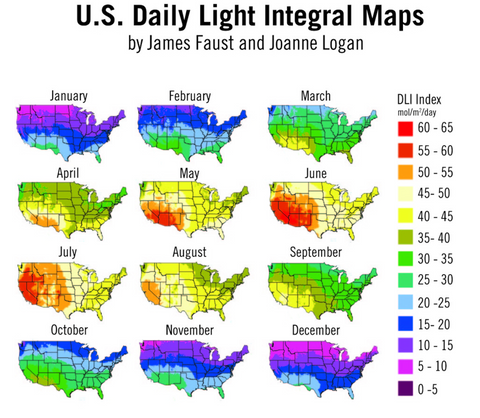What Is Daily Light Integral?

In the past, biologists used lux or energy meters to quantify light intensity. They start to using PPFD to measure light when they realized that photon flux in the 400-700 nm range was an important factor driving the photosynthesis process. However, PPFD is usually expressed as photon flux per second. Daily light integral (DLI) is another effective way of monitoring photosynthetic light in greenhouses. Light intensity varies throughout the day in the greenhouse, depending on the time of day, the position of the sun in the sky, and cloud cover. Therefore, the cumulative amount of photosynthetic photon flux that crops receive during the day may be a more meaningful way to measure and manage light in greenhouses.
Definition of Daily Light Integral
Daily Light Integral (DLI) describes the number of photosynthetically active photons (individual light particles in the 400-700 nm wavelength range) delivered to a specific area in a 24-hour period, also defined as the amount of PAR received per day, is a function of light intensity and duration (days). The unit of DLI is: mol/ m−2 d−1.
DLI calculation formula: PPFD (μmol/m²/s)*photoperiod(seconds)/1000000
Effects of DLI on plants
DLI has significant effects on plant growth, including root and shoot growth, stem thickness, plant height, branching, flower volume, and flowering time. All of these factors have a large impact on yield and overall crop quality. Low light has many negative effects on many plants, the most notable being slow growth and reduced yields. Low DLI also limits the quality of the fruit in terms of sugar content, dry weight and flavor.
You may be thinking, so what is the DLI for each type of crop? The answer is that there is no uniform standard. Because plants will grow in very low light, but the quality will be poor. And DLI is also affected by various factors.
For propagating seedlings and many young cuttings, a low DLI of 6 to 8 mol/m-2/d-1 is recommended. The recommended minimum average DLI is 10 to 12 mol m–2 d–1 for most full-sun annual herbs and perennials grown in moderate temperatures (eg, 65 to 70º F).
There are DLI recommendations, but these values are conditional and depend on growing temperature and desired plant mass.
| Plants | Recommended | ||
| PPFD(μmol/m−2 s-1) | Light On(hour) | DLI(mol/m−2 d−1) | |
| Basil | 231-496 | 14-18 | 15-25 |
| Chinese cabbage | 278-556 | 6-10 | 10-12 |
| Broccoli | 231-810 | 12-14 | 15-35 |
| Kale | 325-444 | 10-12 | 14-16 |
| Strawberry | 298-579 | 12-14 | 15-25 |
| Mint | 200-463 | 12-14 | 10-20 |
| Pea | 250-382 | 8-10 | 9-11 |
| Pumpkin | 386-695 | 14-18 | 25-35 |
| Rosemary | 232-556 | 8-12 | 10-16 |
| Spinach | 298-394 | 12-14 | 15-17 |
| Watermelon | 386-595 | 14-18 | 25-30 |
| Tomato | 340-600 | 14-18 | 22-30 |
| Chili | 300-600 | 14-18 | 20-30 |
| Cucumber | 350-600 | 14-16 | 20-30 |
| Coriander | 300-463 | 12-14 | 15-20 |
DLI map
James Faust of Clemson University and Joanne Logan of the University of Tennessee worked together to study and map the DLI map. This map shows the monthly DLI data of the U.S. outdoor, and also reflects that the DLI is affected by factors such as latitude, month, and sunshine time. DLI maps are valuable because they allow growers to better manage the light environment of their plants. "For example, one can estimate the number of days per year that supplemental lighting is required to achieve desired plant growth in winter, or how much shade cloth might be required to reduce the amount of light delivered to crops in summer," Faust said.

